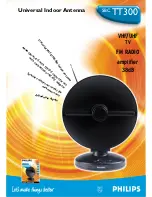
12
1.6.3.2
Azimuth Antenna Pattern
- (See Figure 1-1 for Typical Azimuth Pattern.)
In the principal azimuth plane the antenna has a minimum azimuth beamwidth of 1.35 degrees at the
-3 dB power point and a maximum beamwidth at the -20 dB power point of 4 degrees; sidelobe level
is -24 dB for the Lowbeam and -22 dB for the Highbeam. For the Lowbeam at 30 degrees above the
elevation peak of the beam, the -3 d13 beamwidth is 1.35 degrees minimum and 5.5 degrees
maximum at the -15 dB power point; the maximum azimuth sidelobe level is -16 dB. For the
Highbeam at 28 degrees above the peak of the beam, the -3 dB beamwidth is 1.35 degrees minimum
and 6 degrees maximum at the -15 dB power point; the maximum sidelobe level is -15 dB. At a point
on the ground side of the peak of the passive pattern that is 20 dB below the maximum power point,
the -3 dB azimuth beamwidth is 1.1 degrees minimum and 3 degrees maximum at the -10 dB power
point. The maximum backlobe power level is -32 c113 for both beams at all elevation angles.
1.6.3.3
Elevation Patterns
- (See Figure 1-2 for Typical Elevation Pattern.)
The elevation patterns have a 4.8 degree minimum -3 dB beamwidth and approximately a cosecant
squared power pattern up to 30 degrees above the peak of the normal pattern and 28 degrees above
the passive pattern. On the ground side of the peak-of-beam the pattern is down more than 20 dB
relative to the peak power point of each respective pattern at an angle of 4.1 degrees (active) and 5.1
degrees (passive) below the lower -3 dB elevation pattern power point With the antenna set so that it
is horizontal mechanically, the peak of the normal and passive beams are at approximately 2.0 and
5.7 degrees respectively. The two values will vary slightly from antenna to antenna.
1.6.3.4
Other Antenna Specifications
The peak-of-beam antenna gain is 33.5 d13 (Lowbeam) and 32.5 (Highbeam) above an isotropic
source. The principal elevation and azimuth plane ICR (rain clutter rejection) is 22 dB minimum.
The input VSWR of each feed is better than 1.3:1 over the entire operating frequency range of 2700
to 2900 MHz. The antenna is capable of operating in winds up to 85 knots and will withstand winds
up to 130 knots non-operational.
1.6.3.5 Antenna
Reflector
The reflector is formed by contour plates riveted together to form a support structure onto which a
reflecting surface of expanded aluminum is welded. The basic accuracy of the reflecting surface is
determined by the contour plates which are fabricated by numerically controlled machines. A welded
backstructure, consisting of aluminum tubes and channels, aids in transferring windloads into the
reflector support. A section of screen in the center of the reflector is removable so a test antenna can
be mounted to check electrical characteristics of the dual feed. Three discs attached to the reflector
form targets used to check feed location. The top of the reflector forms a mounting pad for the LVA
SSR antenna.
Summary of Contents for 174100
Page 17: ...17 Figure 1 1 Typical Pattern Azimuth...
Page 18: ...18 Figure 1 2 Typical Pattern Elevation...
Page 19: ...19 Figure 1 3 Polarizer Schematic...
Page 20: ...02 08 2016 SDR ASR11 052 TI 6310 59 20...
Page 22: ...22 Figure 3 1 Complete Antenna Installation...
Page 23: ...23 Figure 3 2 Shipping and Support Stand...
Page 33: ...33 Figure 3 3 Base Interface Kit PSR Base Assembly...
Page 35: ...35 Figure 3 4 Fixed Feeds Unit Installation...
Page 42: ...42 Figure 3 5 Ladder Kit Installation...
Page 45: ...45 Figure 3 6 PSR SSR Interface Mount Installation...
Page 49: ...49 Figure 3 7 Antenna Lift Kit Installation...
Page 54: ...54 Figure 3 8 Waveguide Installation...
Page 55: ...55 Figure 3 9 Waveguide Hanger Installation...
Page 61: ...61 Figure 3 11 SSR Coaxial Cable Installation and Tilt Scale Bracket Installation...
Page 65: ...65 Figure 3 12 Antenna Feedhorn and Tilt Alignment Contour Cheek...
Page 66: ...66 Figure 3 13 Antenna Azimuth Alignment...
Page 67: ...67 Figure 3 14 Counterweight Installation...
Page 81: ...02 08 2016 SDR ASR11 052 TI 6310 59 75 This Page Intentionally Left Blank...
Page 82: ...76 Figure 4 1 Polarizer...
Page 83: ...77 Figure 4 2 Polarizer Motor Replacement...
Page 87: ...81 Figure 5 1 Test Antenna Kit...













































